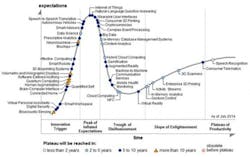Three Simple Rules for a Winning Gamification Strategy in the Plant
While researching my recent story advocating more gamification the plant floor, I found more references and examples for the method dated 2013 and 2014 than in recent years. Gamification still exists, and most people know what it is—using game-like structures and rewards to achieve a company goal back—but where’s the innovation been?
Where’s the killer app that’s like Candy Crush for manufacturers? There are solutions, such as Badgeville, though no panaceas for middling employee engagement seem to be readily available, according to my weeks of interviews and Internet scouring. And there needs to be one, as Gallup research found that companies with highly engaged workers produce 147% higher earnings per share than their peers, though only 13% of employees worldwide would be considered engaged.
Why do things seem a bit stagnant in this sector even though video games are more popular than ever? Gamification was right above augmented reality on the 2014 Gartner Hype Cycle, both dipping into the trough of disillusionment. Four years later, AR is transforming nearly every facet of tech, while gamification not so much.
One issue is that manufacturers are less forthcoming about the specific strategies that give them a competitive edge. And they should be, of course, but there’s more to it.
“[Gamification] was a buzzword at the beginning,” says John Mills, EVP of Business Development at Rideau Recognition Solutions, concerning gamification, which his company deploys. “I think people were perhaps not investing in the right game or structure. Now more are stepping back and taking harder look.”
That makes sense. In any game, except for maybe Calvinball, there’s a set of rules to follow—and consequences for not knowing them. The first time I played Settlers of Catan, the extremely complicated, cutthroat German game, I got my butt kicked because I didn’t take time to learn the all different facets of building roads, making trades and obtaining resources. A few games later, I was just as cutthroat as the rest of my family, even winning a few times before we had to retire the game for the well-being of the family. (If you’ve played, you know this all too well.) The point is, at least skim the rules before jumping in.
Here’s three quick ones Mills offered to get you in the game instead of standing on the sidelines.
Rule #1 for gamifying the plant would be to know who's playing. This means the manager who needs to reduce scrap, for example, needs to talk to the employees, understand what’s happening day-to-day, and find out how they think the problem should be corrected. At the same time, research what they like to do and what they value so you know what the proper motivation should be.
“If the manager isn't building that relationship with the employee, then they're not exuding the behaviors you want to happen, they're not being measured properly, and not being rewarded properly,” Mills says.
Rule #2 would be to make sure the game is accessible and equitable to everyone to secure proper engagement. “More engaged employees do offer better results,” Mills says.
Again according to Gallup, teams with high employee engagement rates are 21% more productive. With your equipment, you can calculate what an increase like this would mean to profits, but getting most or all of your workers to produce this much more? That could lead to exponential growth across the board.
As for how to make a gamification project fair to all, keep the theme general, Mills says. Centering something around general interest sports like the Kentucky Derby or Olympics would be fine, as long as the results are measurable. But something around a big boxing fight or golf tournament might leave out those with little interest in the subject. Always refer to Rule 1 if you’re not sure here.
Rule #3 is about what to give. Mills says experiential rewards are trending. Instead of a new television as the top prize, a day at the spa, mountain climbing or parachuting has been popular. Keep it demographic neutral, though, to make sure workers of all ages would enjoy it.
“It’s a unique time in any company where you have so many different generations in the workforce: Baby Boomers Gen X, Gen Y, people coming in at 18,” Mills says. The right game and prizes that appeal to all could also strengthen the bonds between these generations.
“That gives the person who is more senior a chance to be a mentor, use their great experience and help guide that new employee and share in the rewards,” Mills says.
Caution: One major issue could be that while you are attempting to change employee behavior to get a desired result, employees may be changing the numbers on the system to get the desired prize.
“The biggest mistake one could say is when people game the system, meaning they use gamification to win a prize and in the meantime, they do not fill out the CRM system correctly or honestly,” says Nicolas Babin, former CEO of Sony Europe and noted gamification expert.
That doesn’t mean give a garbage prize out, but the focus should be on the accomplishment. “You should never give a reward without recognition tied to it, but recognition can be given without a reward,” Mills says.
Nearly 40% of millennials want more recognition at work, according to O.C. Tanner, so a simple memo about top performers for the month could be the most rewarding action of all.
About the Author
John Hitch
Senior Editor
John Hitch writes about the latest manufacturing trends and emerging technologies, including but not limited to: Robotics, the Industrial Internet of Things, 3D Printing, and Artificial Intelligence. He is a veteran of the United States Navy and former magazine freelancer based in Cleveland, Ohio.
Questions or comments may be directed to: [email protected]


